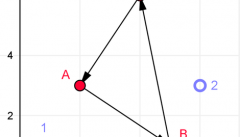
Science Journalism
DID THE PRESIDENT WIN THE PRESIDENTIAL ELECTIONS?
After the election of Mr. Trump in the USA, the American electing system was challenged by the loser camp. The democratic party claimed it was unfair and not democratic. Indeed, Hilary Clinton got more votes than her opponent from the population but less from the electoral colleges. But the democratic camp was not alone, Bernie Sanders supporters had also something to claim because some studies showed that he was able to defeat Mr. Trump in the final round. So, how could we know which candidate democracy would choose? And how can we be sure our electing system is the best?
During the 18th century, Mathematician and philosopher Nicolas de Condorcet defined Condorcet’s Principle: « if a choice is preferred more than all the others by a majority, then this choice has to be elected ». It sounds pretty obvious, but do you really think that this principle is respected in your country? For instance, let’s consider the presidential elections in France, which is a two-round system. It’s a very simple system: each elector chooses a candidate among a list, then the two candidates with the most votes are selected for the second round, finally, the electors chose their favorite between the two and the winner is the one with the more votes. Then the principle is respected because, at the end, the winner has more than 50 % approval…
Do you really think it is? To prove the opposite, we are going to consider the example of the 2007 elections: Mr. Sarkozy won the elections at the 2nd round against Ms. Royale. A few weeks after a study showed that Mr. Bayrou, a centrist candidate, was able to defeat Ms. Royale and Mr. Sarkozy too. Hence, according to Condorcet’s principle, Mr. Bayrou is the winner of this election.
Thanks to Condorcet we know the Two-round system is not the perfect one. But he also did something much better: he invented the electing system that could respect this principle: Condorcet’s method. It is also a simple system: there is a list of candidates and the electors have to class them by order of preference. Then we match every candidate two by two and see in each case who is the winner. If there is a candidate who has all the matches, he is declared Condorcet’s winner!
The only disadvantage of this method is that sometimes the winner does not exist. In some situations ( see the illustration ) where there are three candidates (A, B and C) it is possible that A is prefered to B, B is prefered to C and C is prefered to A. This situation has a name, it is called the Condorcet-paradoxom (him again). This principle also claims that in some situations, it is not possible to have an undeniable winner.
In this case, a solution exists, instead of having a second round ( which would give us the same result), we have to randomize the election. When there are three candidates, the probability for each of them to be elected would be of 1/3. It sounds a bit tricky, but it is the best way to separate the candidates.
This method is not very used currently even it if has the best mathematical properties, the more important being that citizens think their electing system is democratic. But the more interesting looking at the electing system is to see that sometimes, it is impossible to stick together individual preferences into a collective one.


